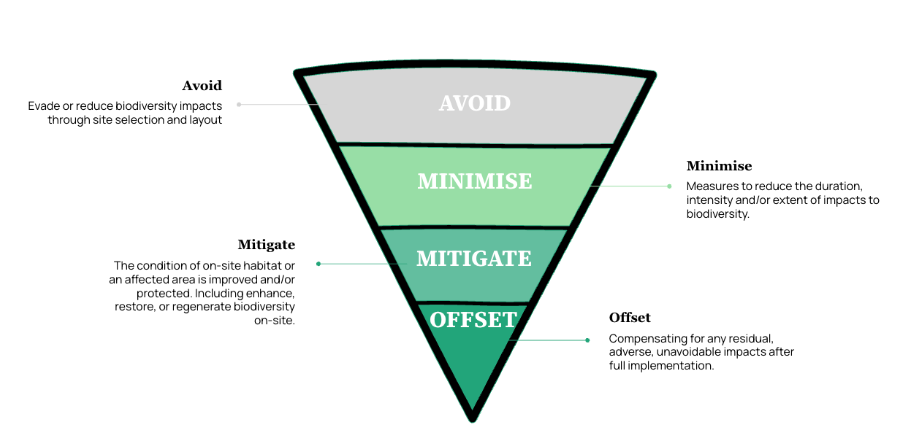Developers are currently presented with three primary mechanisms (or a blended approach) to meet their mandatory 10% Biodiversity Net Gain (BNG) compliance requirements for every planning application post February 2024:
- Delivery of BNG units on-site
- Procurement of off-site BNG units
- Acquisition of Statutory Credits
Options 1 and 2 operate within the private sector, with developers and BNG Habitat Banks (such as naturethrive) playing significant roles. Option 3 serves as a last resort option, enabling developers to purchase BNG units at a capped price determined by the government – purposefully inflated above the private market rates.
In evaluating these options, developers must adhere to the mitigation hierarchy as described in the diagram below: avoid biodiversity loss, minimize unavoidable loss, mitigate residual effects, and, as a last resort, offset or compensate for any remaining loss. Compliance with the mitigation hierarchy will be assessed through the planning process.

Consequently, developers must undertake a thorough assessment of available BNG delivery pathways. It is acknowledged that many organisations are currently engaged in this evaluation, and the subsequent discussion aims to provide pertinent information to inform the decision-making process regarding on-site versus off-site BNG unit delivery.
Many development projects, particularly those encompassing substantial land areas, may present opportunities for the creation of on-site BNG units. Conversely, numerous other developments will lack such capacity. The specific context of each project remains a critical factor in this consideration.
It is important to note that both on-site and off-site BNG unit creation are subject to planning approval. Both approaches also require the establishment, monitoring, and maintenance of habitats for a minimum duration of 30 years, in accordance with a Biodiversity Gain Plan or Habitat Management and Monitoring Plan, following the completion of initial habitat works. A Certificate of Completion will be issued by the relevant Local Planning Authority upon verification of these works.
While a comprehensive analysis of the advantages and disadvantages specific to each developer is required for informed decision-making, the following section outlines key considerations of on-site and offsite approaches.
| On-site BNG Considerations | Off-site BNG Considerations |
| Can be more cost effective than purchasing the equivalent off-site BNG units, depending on the level of biodiversity found on-site and how much additional land is available. | One off payment, no further financial risks. |
| Can improve the aesthetics of the development – helping potential buyers and/or tenants be better connected with nature – making the spaces created more appealing to occupy. | BNG restrictions on the ability to further develop the site in the future. |
| Ongoing surveys and the Biodiversity Gain Plan are to be led by the Developer. | No obligation for the developer to monitor and maintain the agreed Biodiversity Gain Plans. |
| Risks are to be managed by the Developer and penalties are enforceable should the Biodiversity Gain Plan not be adhered to over the 30 year period of agreement. | No risk of enforceable penalties should the Biodiversity Gain Plan not be adhered to. Risk and liability is with off-site landowner and BNG Habitat Bank Operator. |
| The Biodiversity Gain Plan is to be approved within the same planning application associated with the project. | A Developer submits the same Biodiversity Gain Plan but with details being provided by the off-site BNG provider. |
| Sustainability/ESG Reporting opportunity on how you are measurably improving biodiversity and nature found on-site. | Sustainability/ESG Reporting and staff engagement opportunity whereby you can visit the sites where you are helping nature to recover and report annually on the measurable uplift you are creating. |
| Over 10% BNG can be delivered, allowing excess units to be sold to third party developers or to be ‘banked’ to offset future impacts. | Confirms compliance to the 10% BNG requirement through the use of on the national biodiversity gains site register. |
naturethrive has a team of BNG experts to provide complete BNG compliance support – from on-site to off-site requirements – applying the mitigation hierarchy and consideration of all the other critical factors on navigating this new piece of planning legislation. For a free review of any developments please contact hello@naturethrive.co.uk.


